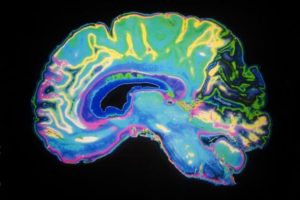MRI or Magnetic Resonance Imaging is one of the most reliable imaging technologies these days. Flawless detection of diseases accentuates the pace of treatment and recovery. MRI is particularly important for patients, suffering from critical ailments.
The critical enzymatic reactions within the human body leave behind some traces easily recognizable through imaging MRI is one such of identifying the action-reaction process of the critical enzymes and hormones. Especially for Brain related imaging. MRI stands unmatched.
Thyroid secretion abnormalities take a direct toll on health. A recent study has established a connection between the brain’s structural abnormalities and hyperthyroidism. The study particularly focused on the impact of thyroid hormone abnormalities on people with Graves’ Disease. The team of researchers took the help of an MRI scan to substantiate this relation.
Graves’ Disease
The thyroid is one of the most significant hormones secreted by the human body. When the level of secretion falls short or exceeds the normal levels, the body responds to it in many ways. However, certain pre-existing health conditions may also trigger this problem of abnormal thyroid secretion.
Graves’ Disease is one such condition that enhances the level of Thyroid secretion. The butterfly gland in the throat, also known as the Thyroid, controls and regulates many physiological functions. With abnormal secretion, the patient experiences several problems. The common symptoms indicating hyperthyroidism are as follows.
- Fatigue
- Weight Loss
- Irregular Heartbeat
- Sweating
- Reduces tolerance to heat
- Enlarged Thyroid gland
- Muscle Weakness
- Shaky Hand
- Increased level of stress and anxiety
- Troubled Sleeping
- Tachycardia
While these are the most commonly observed symptoms of GD, these can also be an indication of several other diseases. Therefore, these symptoms are not proof enough to blame GD as a source of hyperthyroidism or brain structure issues. The researchers needed more than the physical or psychological manifestation of the disease. Hence, they opted for MRI.

The Study
Researchers used MRI for solving the mystery of GD as a source of thyroid hormone malfunctions. The outcomes were quite enlightening and startling at the same time. The findings revealed that the connection between hyperthyroidism and structural change in the brain runs deeper than ever thought. As a result, the researchers could opine that physiological brain changes remain assertively associated with hyperthyroid conditions.
The study got published in the “Clinical Endocrinology and Metabolism” journal. The researchers examined the case history and medical data of 62 women with GD. The team considered only those who were recently detected with the disease.
The participants had to go through a brain MRI, a thorough mental symptom assessment, and treatment procedures for hyperthyroidism. The team of researchers followed up with these participants for the next 15 months to collect the necessary data. Finally, the team compared the data of these GD patients with the ones with normal thyroid levels.
The Outcomes Of the Study
Most pathologies impact the level of cognition of the brain. Therefore, the researchers expected structural abnormalities in the brains of women with GD to be traceable in their MTL (medial temporal lobe) region.
The findings further showed that before the treatment process, women with GD had smaller MTL than the ones without GD. GD always enhances the level of thyroid hormone in the body. After treatment, when the hormonal balance was restored, the volume of MTL returned to its regular size.
Therefore, the team got enough evidence to show that with higher thyroid levels in the body, the structural characteristics of the brain get significantly altered. Helena Filipsson Nyström works as the Assistant Professor at the Gothenburg University’s endocrinology department.
Helena mentioned that this relationship between brain structure and hyperthyroidism could be a game-changer for the medical care domain in the future. She further added that many patients used to complain about not feeling recovered after treatment as well. With this study and its findings, the team can now cast more light and insight into what goes on in the brain.
However, the authors further mentioned that the current findings could be significant but not final for their research. The intimate relation between brain structure and hyperthyroidism is beyond any doubt now. But, there lay many more riddles to decipher.
The study established the significance between brain and hyperthyroidism, unfolding several other questions on the matter. Helena mentioned that this study opened further opportunities for examining the brain’s response to a toxic Goiter. Therefore, the study was significant in two ways. First, it threw light on things that were long ignored. Second, it ensured the path for future revelations critical for treating hyperthyroidism.
Imaging is undoubtedly one of the pillars of the medical care and diagnostic industry today. At sepStream®, we make sure that you do not have to bother about imaging solutions or their prices. Our range of intuitive software solutions related to imaging is affordable and top-end. We offer industry-leading software solutions to ensure a smoother and more effective treatment process.